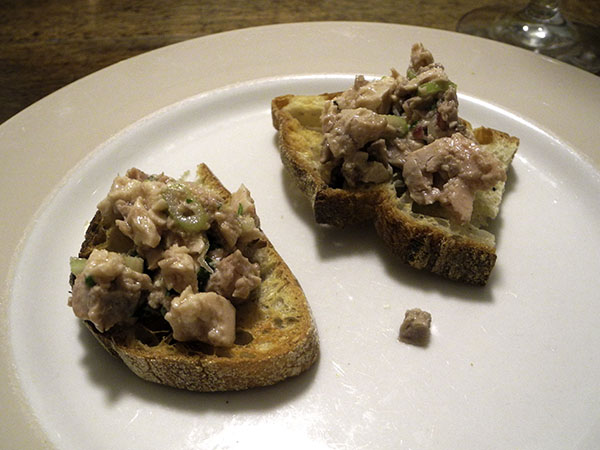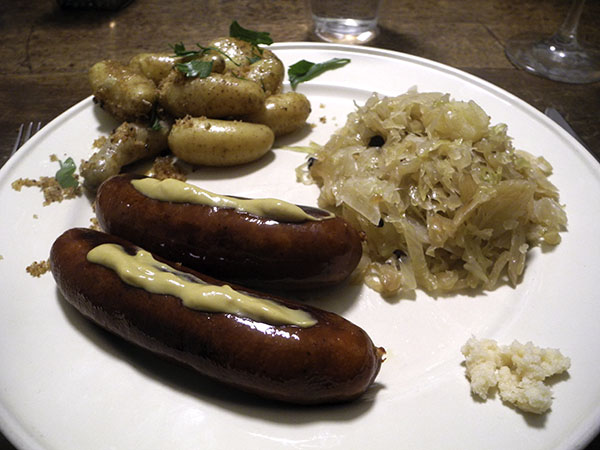
It was a Germanic meal, and a pretty darn good one.
- four ounces of Norwegian canned cod liver, King Oscar Lofot Torskelever (from the Schaller & Weber store, served with little more than pinches of a few condiments (freshly-ground black pepper, Sicilian wild fennel pollen from Buon Italia, chopped celery leaves from , sliced Japanese scallion from Norwich Meadows Farm, and a bit of juice from an organic Whole Foods Market lemon)
- toasted slices of Orwashers Moroccan olive bread (rustic wheat, white flours; black, green, Kalamata; Moroccan spices)

The entrée was very German, with a few small tweaks, and while the local German sausage, with the New Mexican hot pepper was really, really good, I thought both of the vegetables were pretty astounding. It’s all about our terrific local farmers, and GrowNYC, for getting them to us.
I love cabbage of any kind, and Sauerkraut in any form, but I chose the less familiar (and Rhenish?) ‘Weinkraut’ for this meal, because we were going to be drinking a good riesling.
- the Wurst was German, with spice, so it was modern German: four smoked spicy Hatch Chile sausages, also from Schaller & Weber, pan seared until they looked a little blistery, served with a classic German mustard, Löwensenf Medium and a dollop (occasionally refreshed) of the contents of a tube of ‘Meretina‘ horseradish spread, again, soured from Schaller & Weber
- in Germany the potato dish is described as Saltzkartoffeln (salt potatoes): it starts with some incredibly sweet, buttery small fingerling new potatoes from a farm whose name, unfortunately, I had somehow forgotten to record when I bought them in the Union Square Greenmarket weeks ago, scrubbed, boiled whole and unpeeled in heavily-salted water until barely cooked through, drained, halved, dried in the still-warm vintage Corning Pyrex Flameware blue-glass pot in which they had cooked, barely a tablespoons of Organic Valley European-Style Cultured Butter added, seasoned with sea salt and freshly-ground black pepper, arranged on the plates and sprinkled with homemade breadcrumbs that had first been browned in a little butter with a pinch of salt, garnished with chopped parsley from Alex’s Tomato Farm in the Saturday 23rd Street market
- the Sauerkraut was actually Weinkraut (wine cabbage), and not ‘sour’ at all: one chopped sweet medium Walla Walla onion from Alewife Farm, and one cored, peeled, chopped Idared apple from Samascott Orchards, sautéed in a tablespoon and a half of duck fat inside inside an enameled cast iron oval pot until softened, followed by one 16-ounce glass jar of sauerkraut (simply cabbage and salt) from Millport Dairy Farm in the Union Square Greenmarket that had been drained and very well-rinsed in several changes of cold water, then drained once again, squeezed, and the strands separated, the cabbage braised with the vegetables, stirring for a couple minutes, then 9 smashed whole juniper berries, about the same number of bruised whole black peppercorns, one whole fresh bay leaf from West Side Market, a little salt, and a tablespoon of olive oil added and mixed in, and one cup of a Spanish Rueda, Nisia Verdejo Old Vines 2016 (we didn’t have any spare German wines) the liquid brought to a boil and simmered over a low flame, stirring occasionally, for less than half an hour, covered, then uncovered for about 20 minutes more
- the wine was, well, it’s complicated historically: an Austrian (Weinviertel) white, Riesling “Falkenstein” Dürnberg 2015, from Astor Wines
- the music wasn’t German or Germanic at all, although I suppose it could be described as part of a shared Frankish culture and history: Charpentier’s 1686 opera, ‘La descente d’Orphée aux enfers’